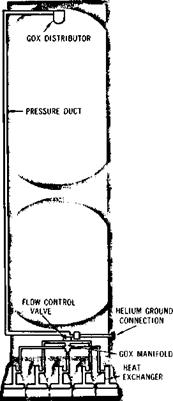LOX PRESSURIZATION SYSTEM
Pressurizing gases used in the LOX tank are helium, gaseous oxygen, and nitrogen. These gases are used in prepressurization, flight pressurization, and storage pressurization.
LOX cannot exceed -297 degrees Fahrenheit or
Prepressurization is necessary 45 seconds prior to
|
SATURN V NEWS REFERENCE
engine ignition to give sufficient tank ullage pressure for engine start and thrust buildup. Helium, used as the pressurizing gas to reduce flight weight, is supplied by ground support through the helium ground connection. It proceeds up the gaseous oxygen line into the LOX tank through the GOX distributor. The flow of helium is monitored by the pressure duct and stopped at 26 pounds per square inch absolute (psia) maximum and is resumed when the pressure drops to 24.2 psia during engine start. Ground-supplied helium is available until liftoff. GOX is added to the LOX tank for pressurization during flight. Each engine contributes to GOX pressurization. A portion of LOX—6,340 pounds — passing through the engine is diverted from the LOX dome into the engine heat exchanger where hot gases exhausted from each engine turbine transform LOX into GOX. The GOX flows from each heat exchanger into the GOX line manifold through the flow control valve, up the GOX line, and into the LOX tank through the GOX distributor. The GOX flow is approximately 40 pounds per second to maintain a LOX tank ullage pressure of 18 to 23 psia.
|
|
LOX Pressurization
While the booster is being stored or transferred from one location to another, a slight positive nitrogen pressure is maintained for cleanliness and low humidity conditions. The external nitrogen pressure source is removed during flight operations.












